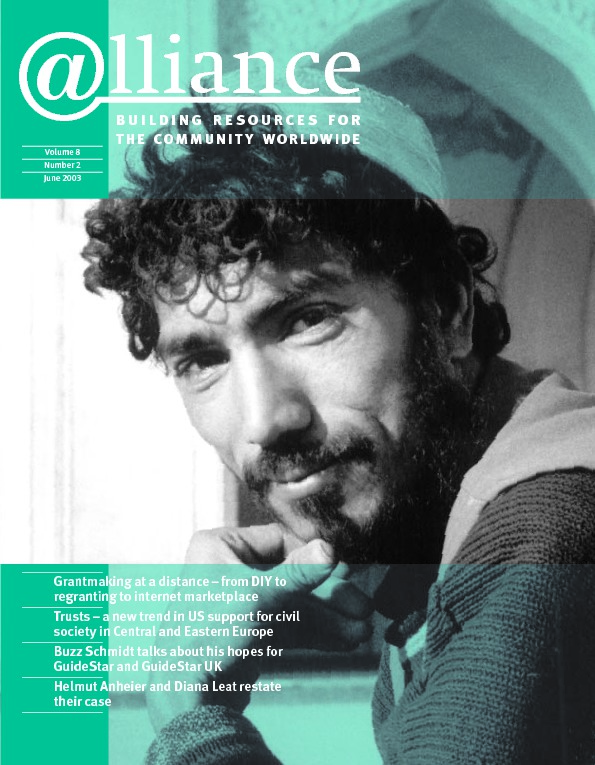As reported in Alliance Bulletin (April 2003), GuideStar UK was launched on 24 March with a £2,885,000 grant from the British government. The aim: to provide more effective access to information about UK charities. How did this come about? And how will Guidestar UK differ from GuideStar in the US? Alliance talked to GuideStar founder Buzz Schmidt.
It all started in May 2002 when Schmidt visited the UK for a series of meetings that included the Inland Revenue, the Treasury and the Charity Commission.[1] Reactions were so positive that Schmidt abandoned plans to do four months’ research at Stanford and came to the UK instead. The upshot was the £2,885,000 grant from the government’s Invest to Save programme, finally approved in late March. GuideStar UK was formally launched a few days later.
Why GuideStar?
Schmidt’s starting point is that while philanthropy is a key part of the social economy, the millions of transactions involved each year ‘are unlike others in our lives because there is so little information to drive decisions’. His initial idea was to provide an information system to support a more efficient marketplace for decision-making by donors and others – the charities themselves, their boards, the regulators, those who provide services for charities (lawyers, accountants, etc). To this end GuideStar provides information about the operations and finances of some 850,000 IRS-recognized non-profit organizations in the USA.
But GuideStar is not an evaluative system. Schmidt is very clear that he has ‘no wish to tell people which are good charities’. Comparative information will enable people to make more informed decisions based on their own values and priorities.
In practice?
Is GuideStar achieving what he hoped? Schmidt originally envisaged individual donors as the main users, but in fact they comprise only 25 per cent of users. Use by others, including institutional donors, has been far greater than anticipated. For this reason the information is not geared towards any particular market. Instead, GuideStar provides generic information for a general market, and people can use data for their own purposes – a kind of ‘public library for the non-profit sector’.
GuideStar also provides customized data to around 30 other organizations to help them meet the needs of their own client groups. Two are Fidelity, which has a GuideStar-powered service for donor advisers on its own website, and AOL, which uses GuideStar data to power a website for online donations. One advantage of this is that it streamlines reporting for charities, who don’t have to provide separate, tailored information for AOL, Fidelity, etc.
GuideStar also offers ‘value-added’ services for specific groups of professionals who subscribe, including lawyers, accountants and programme officers. One such is CharityCheck, which allows grantmakers to validate the current IRS tax status of any non-profit. Another, aimed principally at charity managers for benchmarking purposes, provides financial analysis of charities.
This analysis explores the broad financial performance of each charity alongside the aggregated experiences of like charities but does not name the similar organizations. As a former fundraiser for an international development agency, Schmidt stresses the dangers of constructing league tables around ratios such as overhead and fundraising without looking at the context. ‘What you do need is transparency – to know what the overhead is and what it covers. Information allows people to find the charities whose work is most consistent with their own values.’
GuideStar in the UK
How will the UK version of GuideStar differ? For Schmidt the key difference is the initial government support for the idea and the opportunities for collaboration with government agencies. In the US there is no government money, though the IRS does have a contract to buy data from GuideStar. This is likely to mean that the quality and value of the data develop much faster. There is also over eight years’ experience in the US to build on.
But, he points out, the situation is much more complex in the UK, with different regulatory regimes in different parts of the country and ‘the entire conception of the charitable sector in flux’.[2] In fact, Schmidt feels this is part of the reason why the government was so interested in GuideStar. ‘There was a real convergence of reasons for streamlining information provision by charities and having a more efficient marketplace without external over-regulation.’
People talk about how far ahead the US is in terms of philanthropy. Schmidt doesn’t see it this way. He is impressed by the way people in the UK think in terms of using government in a constructive way. ‘People here are far more interested in getting things right.’
1 Largely at the instigation of Hilary Browne-Wilkinson of the Institute of Philanthropy (IOP), who was interested in the way GuideStar seems to overcome the problem of how to present useful information that really compares like with like.
2 The recent Strategy Unit report recommends a redefinition of charitable purposes and major changes in the regulatory system. See Alliance, Vol 7, No 4, December 2002, p47.
For more information about the launch of GuideStar UK, see http://www.fdncenter.org/pnd/news/story.jhtml?id=29300005
http://www.guidestar.org






Comments (0)